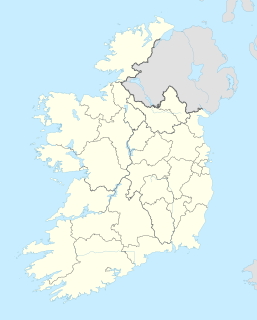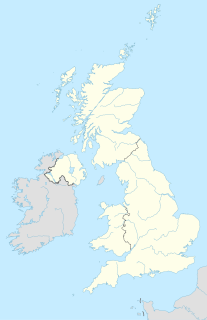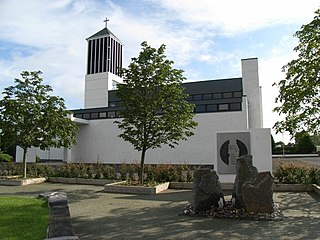
Draperstown is a village in the Sperrin Mountains in County Londonderry, Northern Ireland. It is situated in the civil parish of Ballinascreen and is part of Mid-Ulster district. It is also part of the Church of Ireland parish of Ballynascreen and the Catholic parish of Ballinascreen, and within the former barony of Loughinsholin. The village had a population of 1,772 people in the 2011 Census.

Ballycastle is a village in County Mayo, Ireland, situated northwest from Ballina, near Mayo's north coast. It lies on the edge of the Mayo Gaeltacht.

Ballymakeera or Ballymakeery is a small townland and Gaeltacht village in the civil parish of Ballyvourney, barony of Muskerry West, county Cork, Ireland.

Ballyvourney, is a Gaeltacht village in southwest County Cork, Ireland. It is a civil parish in the barony of Muskerry West, and is also an ecclesiastical parish in the Roman Catholic Diocese of Cloyne.

Ballinadee is a village in County Cork, Ireland. It lies in the parish of Courceys, some 12 km by road west of Kinsale and 9 km south east of Bandon.

Newtownhamilton, sometimes referred to as Baile Úr, is a small town and civil parish in County Armagh, Northern Ireland. It lies predominantly within Tullyvallan townland. The civil parish is within the historic barony of Fews Upper. In the 2011 Census it had 2,836 inhabitants.

Ballyscullion is a small village and civil parish in County Londonderry, Northern Ireland. In the 2001 Census it had a population of 291 people. The civil parish of Ballyscullion covers areas of County Antrim as well as County Londonderry. The village is situated within Mid-Ulster District.
Ballyvoy is a small village and townland in County Antrim, Northern Ireland. It is on the main A2 coast road 5 km east of Ballycastle and 17 km north west of Cushendall. In the 2001 Census it had a population of 72 people. It lies within the Antrim Coast and Glens Area of Outstanding Natural Beauty and is part of Causeway Coast and Glens District Council.

Chapelizod is a village preserved within the city of Dublin, Ireland. It lies in the wooded valley of the River Liffey, near the Strawberry Beds and the Phoenix Park. The village is associated with Iseult of Ireland and the location of Iseult's chapel. Chapelizod is under the administration of Dublin City Council.
Ballinderry is a small civil and ecclesiastical parish on both sides of the County Londonderry / County Tyrone border in Northern Ireland. It is a rural parish of about 350 houses and lies on the western shores of Lough Neagh.

Ballerin is a small village between Garvagh and Ringsend in County Londonderry, Northern Ireland. It is located within Causeway Coast and Glens district. It includes Saint Columba's Catholic primary school and Saint Mary's Catholic church.

Castletown is a small village and also a parish in County Laois in Ireland.
Ballynagarrick is a townland situated outside Craigavon, County Armagh, Northern Ireland. The literal translation of the name means town (land) of the rocks, and indeed in bygone days two quarries were situated on the small townland.

Cloughaneely is a district in the west of County Donegal, Ireland. This is a mainly coastal area with a population of over 4,000 centred on the towns of Falcarragh and Gortahork. It is a Gaeltacht area, meaning the Irish language is spoken as the primary language. Cloughaneely includes the secondary school Pobalscoil Chloich Cheannfhaola, with just under 500 students. Places of interest include Cnoc na Naomh, considered to be a mountain with religious significance. Cloughaneely, The Rosses and Gweedore, known locally as "the three parishes" with 16,000 Irish speakers, together form a social and cultural region different from the rest of the county, with Gweedore serving as the main centre for industry.

Herbertstown is a village in south-eastern County Limerick, Ireland. It is part of the ecclesiastical parish of "Hospital and Herbertstown", in the Roman Catholic Archdiocese of Cashel and Emly.

Old Parish is a village in west County Waterford, Ireland. It is part of the Ghaeltacht in Waterford Gaeltacht na nDéise.

Yellow Furze is a small village in County Meath, Ireland. It is located 5 km southwest of Slane, on the boundary between the townlands of Dollardstown and Seneschalstown.
Bangor is a civil and ecclesiastical parish in County Down, Northern Ireland. It is located in the north of the Ards Peninsula, consisting of 30 townlands, twenty-two and a half of which lie in the barony of Ards Lower, with seven and a half lying within that of Castlereagh Lower. Its ancient monastery was of ecclesiastical importance.
Finglas is a civil parish mainly situated in the barony of Castleknock in the traditional county of Dublin, Ireland. It contains 34 townlands. Today, the parish is split between the modern local administrative units of Fingal and Dublin City Council.












